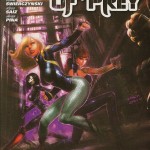 On a lot of levels, the reboot of Suicide Squad has been a hot mess. It started with a psychological torture tale, moved into a zombie story and then transitioned quickly into a prison break movie with almost no segues or fanfare… and that’s all in what’s supposed to be a single, cohesive, five-issue story arc. In many ways it’s a failure, but what’s saving it is two things: a total commitment to the primary characters on the part of writer Adam Glass… with the keyword there being “primary,” because the second saving grace is the apparent willingness to kill just about any character at any time.
On a lot of levels, the reboot of Suicide Squad has been a hot mess. It started with a psychological torture tale, moved into a zombie story and then transitioned quickly into a prison break movie with almost no segues or fanfare… and that’s all in what’s supposed to be a single, cohesive, five-issue story arc. In many ways it’s a failure, but what’s saving it is two things: a total commitment to the primary characters on the part of writer Adam Glass… with the keyword there being “primary,” because the second saving grace is the apparent willingness to kill just about any character at any time.
By the time this issue rolls around, what’s left of the Squad (We’ve lost one or two via simple escape, gunshot wound, the odd zombie attack and fatal viral infection… only some of which may have been passed on by Harley Quinn) is stuck behind bars, infected with something called the Rot Virus (Yeah, sounds like Harley) and charged with quelling a prison riot before the bombs they had stuck in their brain stems. So long story short, Glass is throwing everything at the wall to amp up the tension. Deadshot’s out of bullets. El Diablo might have to kill someone. Waller’s trapped two floors above the riot. And the tension works… for those characters.
When I was a kid, I developed a theory called “Murder She Wrote Logic,” which was borne out of (duh) Murder She Wrote. Whenever you watched that show, you didn’t need to look at the evidence or the logic or anything else; all you had to do was look at who was least likely to be the killer, and you knew that they were the perp. You can use the same logic on Suicide Squad: whichever characters are drawn in broad strokes are doomed. The aforementioned Deadshot, El Diablo and Amanda Waller are well drawn out with reasonably solid dialogue and characterization, so they make it. Others like Yo-Yo, and Voltaic in the first issue? Meat for the machine, man. It’s an area where the book falls down; yeah, Glass will kill members of the team – something you’d expect to see in a book called Suicide Squad – but you can pretty much call who’s dead the first time they speak. They might as well show Deadshot a picture of their grandkids and tell him how many days they have left until retirement.
 I think I finally have realized the reason behind the vague sense of dissatisfaction, if not downright unease, that I’ve been feeling reading Geoff Johns’s and Jim Lee’s Justice League: these characters don’t act right. At best, they act like versions of the original characters that have suffered an extended and untreated fever, or perhaps some period of natural gas-related asphyxia, or some other unknown cause of mild brain damage.
I think I finally have realized the reason behind the vague sense of dissatisfaction, if not downright unease, that I’ve been feeling reading Geoff Johns’s and Jim Lee’s Justice League: these characters don’t act right. At best, they act like versions of the original characters that have suffered an extended and untreated fever, or perhaps some period of natural gas-related asphyxia, or some other unknown cause of mild brain damage.








 Podcast RSS Feed
Podcast RSS Feed iTunes
iTunes Google Play
Google Play Stitcher
Stitcher TuneIn Radio
TuneIn Radio Android
Android Miro Media Player
Miro Media Player Comics Podcast Network
Comics Podcast Network